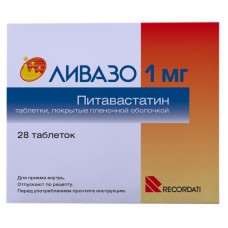Expiration date: 08/2026
Release form, composition and packaging
Tablets, film-coated white color, round, lenticular, cross cut - white; on one side of the tablet is engraved "KC" on the other - engraved "1". 1 tablet contains:
pitavastatin calcium 1.045 mg,
that corresponds to the content of pitavastatin 1 mg
Tablets, film-coated white color, round, lenticular, cross cut - white; on one side of the tablet is engraved "KC" on the other - engraved "2". 1 tablet contains:
pitavastatin calcium 2.09 mg,
that corresponds to the content of pitavastatin 2 mg
Tablets, film-coated white color, round, lenticular, cross cut - white; on one side of the tablet is engraved "KC" on the other - engraved "4". 1 tablet contains:
pitavastatin calcium 4.18 mg,
that corresponds to the content of pitavastatin 4 mg
Excipients: lactose monohydrate - 252.34 mg hyprolose nizkosoleva - 50.16 mg, hypromellose - 5.32 mg, magnesium aluminometasilicate - 6.4 mg, magnesium stearate - 1.6 mg.
The composition of the film shell: Opadry white - 9 mg, including polymer - 5.952 mg, titanium dioxide - 2.409 mg, trimetilatsetat - 0.594 mg, silicon dioxide colloidal - 0.045 mg.
Clinico-pharmacological group: Lipid lowering drug
Pharmaco-therapeutic group: Hypolipidemic agent - HMG-COA reductase inhibitor
Testimony
— primary hypercholesterolemia, including heterozygous familial hypercholesterolemia (hyperlipidemia type IIA on the Fredrickson classification) or mixed hypercholesterolemia(hyperlipidemia type IIb according to the classification of Frederickson), hypertriglyceridemia (hyperlipidemia type IV but the classification of Frederickson) as an adjunct to diet when diet and other non-pharmacological treatments (e.g. exercise, weight reduction) are inadequate.
ICD-10 codes
The dosage regimen
Inside, the tablet must be swallowed whole.
Preferred taking the pill at the same time of day, better evening, in accordance with the circadian rhythm of lipid metabolism. Before treatment and in the process, patients must adhere to a cholesterol-lowering diet.
The initial dose of 1 mg/day one. If necessary, increase the dosage at intervals of not less than 4 weeks to 2 mg/day. The dose should be individualized according to the concentrations of LDL cholesterol, the goal of treatment and response to treatment. Most patients need a dose of 2 mg Maximum daily dose of 1 mg.
Patients with mild and moderate impaired hepatic function: the recommended maximum daily dose of 2 mg.
Patients with impaired renal function: when impaired renal function mild degree of gaiesti (preferably objectively assess the degree of reflection with KK or glomerular filtration rate), drug Liwat should be used with caution. Data on the use of maximum daily dose of 4 mg if impaired renal function of any severity are limited, so to apply the maximum daily dose of 4 mg is necessary only with careful monitoring of renal function after a gradual increase in dose. Not recommended for patients with severely impaired renal function assigned maximum daily dose of 4 mg; it is recommended to consider limiting the maximum daily dose of 2 mg in severe renal failure.
Elderly patients: dose adjustment is not required.
Side effects
In controlled clinical trials while receiving recommended doses of less than 4% of patients receiving drug treatment, Invaso. were excluded from the study in connection with the development of adverse reactions. The most common was maphia.
Depending on frequency of occurrence there are the following adverse reactions in accordance with the who classification: very common: ?10, often from ?1/100 to <1/10, uncommon: ?1/1000 to <1/100, rare: ?1/10000 to <1/10000, very rare: <1/10000 n frequency unknown (the available data do not allow us to determine the frequency).
Organs of hematopoiesis: rarely - anemia.
From the metabolic: often - anorexia.
Violation of the psyche: often - insomnia.
From the nervous system: often - headache; infrequently - dizziness, taste disturbance, drowsiness.
From the sensory organs: rare - tinnitus; rare - reduction of visual acuity.
With the skin: rarely - itching, a rash; rare - urticaria, erythema.
From the side of musculoskeletal system: often - myalgia, arthralgia; infrequent - muscle spasms.
From the urinary system: rare - pollakiuria.
From the digestive system: often - constipation, diarrhea, dyspepsia, nausea; rarely, abdominal pain, dry mucous membranes of the mouth, vomiting; rarely - glossodynia, acute pancreatitis, cholestatic jaundice.
The laboratory parameters: infrequently - parisenne activity "liver" transaminases ACT, ALT, increased activity of creatine phosphokinase (CPK).
In clinical studies after administration of Livatho observed increased activity of KFK 3 times the ULN in 49 patients out of 2800 (1.8%). Levels exceeding 10 times ULN and more with associated muscle symptoms were rare and were observed only in one patient out of 2406 patients treated with 4 mg of Livatho (0.04%) in the clinical trial program.
Other: often - asthenia, malaise, fatigue, peripheral edema.
Experience in post-marketing use
Two-year prospective study of post-marketing surveillance was conducted in approximately 20,000 patients in Japan. The vast majority of these patients received pitavastatin at a dose of 1 or 2 mg and not 4 mg. Have 10.4 % of patients have been reported adverse reactions, which we can not exclude a causal relationship with pitavastatin, and 7.4% of the patients stopped treatment in connection with the development of adverse reactions. Frequency vozniknoveniya myalgia was 1.08%. Most adverse reactions were mild. For the past 2 years, the frequency of adverse reactions was leaching in patients with a history of drug Allergy (20.4%) or liver disease, or kidney (13.5%).
Adverse reactions and the frequency of occurrence observed in a prospective study, post-marketing surveillance, but not in international controlled clinical trials using the drug and the recommended doses are given below.
The liver and biliary tract: rarely - violation of the liver.
From the side of musculoskeletal system: rare - myopathy, rhabdomyolysis.
In post-marketing surveillance study there were two reports of rhabdomyolysis, in which the patients required hospitalisation (0.01% of patients).
In addition, there are spontaneous reports of effects from musculoskeletal system including myalgia and myopathy in patients treated with, Livatho in all of the recommended doses. Were also received reports of rhabdomyolysis with acute renal failure, and without it, including, of rhabdomyolysis with a fatal outcome.
Was also received spontaneous reports the following adverse reactions (frequency based on cases observed in post-marketing studies).
From the nervous system: rarely - hypoesthesia.
From the digestive system: rarely - abdominally discomfort.
Adverse events the use of other statins:
- sleep disturbances, including nightmares;
- amnesia;
- sexual dysfunction;
- depression;
- interetitsialnogo lung disease;
- diabetes mellitus: frequency vozniknoveniya depends on the presence or lack of risk factors (the concentration of glucose in fasting blood ?5 mmol/l, BMI>30 kg/m2, elevated concentrations of TG, arterial hypertension in anamnesis);
- increase in glycosylated hemoglobin.
Contraindications
- hypersensitivity to pitavastatin, auxiliary components of the drug and other inhibitors of HMG-COA reductase inhibitors (statins);
- severe hepatic insufficiency (more 9 points on a scale child-Pugh), or the class C classification child-Pugh, liver disease and active phase, including a persistent increase in activity of "liver" transaminases in serum (more than 3 times compared with the upper limit of normal (ULN));
- lactose intolerance, lactase deficiency or glucose-galactose malabsorption;
- myopathy;
- concomitant use of cyclosporine;
- pregnancy, lactation, inadequate contraceptive methods in women of childbearing age;
- the age 18 years (effectiveness and safety have not been established).
With caution
At the risk of myopathy/rhabdomyolysis - renal failure, hypothyroidism, personal or family history of hereditary muscular diseases and previous history of muscle toxicity with the use of other inhibitors of HMG-COA reductase or fibrates, excessive alcohol use, age older than 70 years, liver disease in the anamnesis.




